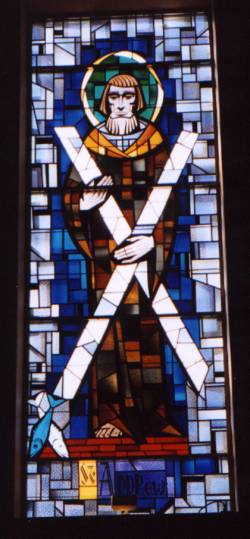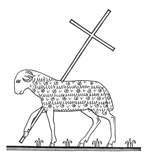
Part One: The Apostles’ Creed
5.
“
He Descended into Hell. On the Third Day, He Rose Again from the Dead”
 There are two truths of faith affirmed in this article of
the Creed. The first is that after Christ died, His soul – separated from the
body – visited the souls of the faithful departed in what has come to be called
the Limbo of the Fathers. The second truth is the Resurrection of Christ from
the grave on Easter Sunday. While the Resurrection of Christ is far more
significant, His descent “into hell” deserves to be better known.
There are two truths of faith affirmed in this article of
the Creed. The first is that after Christ died, His soul – separated from the
body – visited the souls of the faithful departed in what has come to be called
the Limbo of the Fathers. The second truth is the Resurrection of Christ from
the grave on Easter Sunday. While the Resurrection of Christ is far more
significant, His descent “into hell” deserves to be better known.
The Descent of ChristIt is not difficult to trace the origins of the statement that, after He died, Jesus “descended into hell.” Pre- Christian Judaism is clear on the point. By whatever name it was called, Jewish believers by the time of Christ held that there was an abode of the departed just. It was assumed to be a place or state of happiness, temporary, and was to be replaced by a condition of final or permanent bliss when the Messiah came to establish His kingdom. On the strength of this tradition, the Apostles’ Creed affirms the existence of a limbo – distinct from hell and purgatory – for the just who had died before Christ’s ascension into heaven. Because of the Fall, heaven was closed to human beings. In other words, actual possession of the beatific vision was postponed even for those who were purified of all sin. They would enjoy the vision of God only after the Redemption was historically completed by Christ’s visible ascension into heaven. This was implied in the Savior’s promise to the penitent thief on Calvary. “This day,” he was assured, “you will be with me in Paradise” (Luke 24:43). The reason for Christ’s visit to the faithful departed seems evident from the circumstances. He wished to reassure these justified souls that they were, indeed, redeemed and their entrance into heaven was near at hand.
The ResurrectionChristianity as the religion of history and Christ as the living God made man depend on His resurrection from the dead. We shall therefore examine the Resurrection in a series of questions: What is the Resurrection? Why did Jesus Christ rise from the grave? And how are we to make the Resurrection more meaningful in our lives? What is the Resurrection? The Resurrection is the historic event of Christ reuniting His human body and soul, which had been separated by His death on Calvary. Christ had a true human nature, like ours except for sin. Since he had no sin, He need not have died. He chose to die. But by the same free will by which He chose death, He also chose to conquer death and return to the human life He possessed before the first Good Friday. It was the same Jesus Christ who rose on Easter Sunday. It was the same Divine Person united with His human nature. St. Luke describes the scene on Easter Sunday when the Lord appeared to the eleven disciples as they huddled together in the upper chamber in Jerusalem. They were listening to the two disciples who had just been with Jesus on their way to Emmaus: Now while they were talking of these things, Jesus stood in their midst, and said to them, “Peace to you! It is I, do not be afraid.” But they were startled and panic-stricken, and thought they saw a spirit. And He said to them, ”Why are you disturbed, and why do doubts arise in your hearts? See my hands and feet, that it is I myself. Feel me and see; for a spirit does not have flesh and bones, as you see I have.” And having said this, He showed them His hands and feet. But as they still disbelieved and marvelled for joy, He said, “Have you anything here to eat?” And they offered Him a piece of broiled fish and a honeycomb. And when He had eaten in their presence He took what remained and gave it to them (Luke 24:36-43). The apostles were absolutely certain about Christ's bodily resurrection from the dead. This became the foundation of all their preaching. On Pentecost Sunday, Peter told the Jews that the Jesus whom they had crucified had come back to life. And he rested the credibility of the Christian faith on this historical fact. Why the Resurrection? Christ rose from the dead as the crowning miracle of His visible stay on earth. He worked many miracles during His three years of public ministry: paralytics began to use their limbs, the blind were restored their sight, deaf-mutes could hear and speak; Christ calmed the storm at sea with a single command, He walked on water and gave Peter the power to do the same; the dead were raised from the grave. And not long before His Passion, He called the dead Lazarus out of the tomb. On this level, His own resurrection was only the culmination of a series of wonders that made Christ’s astounding doctrine acceptable by the human mind. Moreover, by rising from the dead, He proved that He had overcome sin, which was the original cause of death. Finally, Christ’s resurrection is the promise and prelude of our own final resurrection on the last day. He is, as St. Paul tells us, the first fruits of those who sleep. The mystery of death, which we all naturally fear, is balanced by the confident hope that we, too, will rise from the grave. Our souls are naturally immortal. When they leave the body they remain alive, to enter an eternity whose happiness or misery depends on how well we have served God during our mortal life on earth. Our bodies will decay and return to the dust from which they come. But only for awhile. In God’s own time, provided we have been faithful to the divine will before death, these dead bodies will walk and speak and hear and see again. They will be glorified. This means they will be immortal, never to die again. They will be resplendent with beauty, never again endure pain, and will be able to move through space and matter, not unlike the risen body of Jesus Christ. The Risen Christ Is Alive. Having become man, the Son of god will always remain man. The expression, “Jesus Christ, yesterday, today, and forever” has been literally verified until now and is prophesied into the endless reaches of eternity. In the next article of the Creed, we profess to believe in Christ’s ascension into heaven. But there would have been no ascension unless there had first been a true bodily resurrection. So, too, when we reflect on the Holy Eucharist, the key to understanding the Real Presence is the fact that God became man, died, and rose from the dead. Why is this the key? Because the Eucharist is the Risen Christ living in our midst in the Blessed Sacrament. 
Copyright © 2002 Inter Mirifica
Pocket Catholic Catechism |